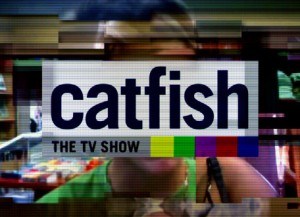
One of the most difficult questions we are left with after reading M Butterfly is how did Gallimard not notice that Song was a man? Or, if he did notice and not say anything, what does that say about Gallimard? As a fan of trashy television shows, I’ve often asked myself similar questions while watching the show “Catfish” on MTV. The show revolves around the concept of online dating and the eternal question that goes along with it: how do you know that the person you’re “dating” is who they say they are? “Catfish” follows the stories of individuals who have never met their significant other in person. The climax of each episode is when the couple finally meets and one of two things happens; either they both are who they say they are and they live happily ever after or one of them is not at all as their online profile displayed them and the other is devastated.
Both M Butterfly and “Catfish” question the idea of love and what it is about someone that we fall in love with. Whereas M Butterfly focuses mostly on gender (is Gallimard gay because he fell in love with a man?) “Catfish” gives us perspective on race, age, economic status, and whatever else makes up a person’s identity. In each of these cases, both with M Butterfly and in every episode of “Catfish,” before the truth of the beloved is found out, the person that the story follows believes him/herself to be madly in love. However, when they find out that the person they love isn’t who they thought he/she was, more often than not they return home, heartbroken and empty handed. So if these people are falling in love with personalities on the internet but the personalities don’t match the bodies imagined to go with them, are these people really falling in love? We like to imagine that we fall in love with a soul, not a body, but if difference between a 22-yr old Caucasian body and a 25-year old African American body is what makes or breaks the relationship, can we claim that love is blind? It is interesting to question M Butterfly through this lens. If Gallimard claims to be in love with Song, when looking at it through this lens, we have to assume he is also in love with Song’s body. Assuming at some point he would have run into some indication that Song is a man, perhaps we can assume that Gallimard is gay, or at least bi-curious. An interesting twist on this is in the movie when Song strips down in front of Gallimard and begs Gallimard to love him. However, in the movie, Gallimard seems disgusted by Song’s male body, much like the participants of “Catfish.” Using the lens of “Catfish,” we are able to see what sorts of characteristics (gender, race, etc.) influence love and can even take priority over pure chemistry.